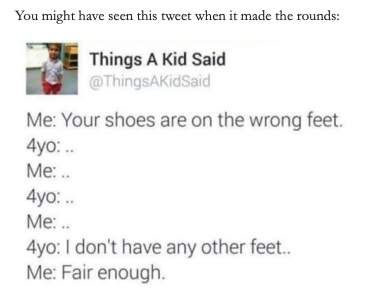Karen Wootton, Odenton, MD karenwootton@cpm.org
You might have seen this tweet when it made the rounds:

After the chuckle, I started thinking What would have happened if the 4-year-old had not spoken up? During the pause in this tweeted conversation, I can imagine the gears turning as the 4YO is making sense of the statement. I can also imagine another outcome where the 4YO does NOT speak up and walks away confused by the conversation. The adult would think the 4YO is going to switch the shoes, while the 4YO is just stymied. There might not be improvement, and nobody would learn.
Students are not always forthcoming with information. It might be that they are shy and not willing to speak, or they might be confused and have no idea of the type of response that is expected. We cannot assume that we know what is going on in students’ heads.
We also cannot assume that we know students’ mathematical histories, so we should not try to guess. Every student experienced something different during the pandemic, and the learning targets that were hit probably varied from student to student. There is a lot of chatter about students having gaps in learning or students falling behind. Behind what? Behind an arbitrary line drawn during better times with the best of circumstances in mind? Everyone experienced an interruption in the normal mode of learning. It is true that some students, particularly those who did not have the structures at home to support continued learning, might have made less progress than others. This is not an argument for assessing students extensively to determine gaps, nor is it an argument for summer school for all to “catch back up.” It is an argument to not make assumptions.
Navigating the classroom in the fall will take a sympathetic caring heart within a teacher who is watching for misunderstandings. Start the school year strong, with the grade level/course material. Spend time doing team building activities and taking advantage of students being with their peers again to build a community of learners within your classroom. Provide just-in-time support when needed, not the just-in-case teaching many are pushing. (See the Professional Learning Departments offerings in the Professional Learning Announcements for support on just-in-time teaching.) For more than a year, teaching has been difficult, and while we hope it will be more like normal in the fall, it will still have its challenges. Lean on your colleagues, at your school, on social media, and at CPM, to help. Keep the growth of your students’ learning at the forefront of your thinking and planning. You’ve got this!

